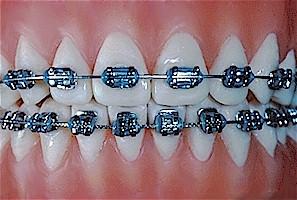What Is Orthodontics?
Orthodontics is a field of dentistry that concentrates specifically on the diagnosis and treatment of dental and facial irregularities such as crooked, crowded, protruding teeth and poor jaw alignment.
Orthodontic treatment is ultimately directed at improving and maintaining excellent dental and oral health, as well as creating an attractive smile. Orthodontics means "straight teeth".
What Is A Malocclusion?
"Occlusion" is the contact of the upper and lower teeth during chewing or when the jaws are closed. Occlusion is commonly called "bite". A person who has an an alignment problem with their teeth or jaw has a "maqlocclusion", which means "bad bite".
When Should Orthodontic Treatment Be Done?
There are on hard and fast rules for the commencement of treatment because everyone is an individual. The American Association of Orthodontists recommends an orthodontic screening examination for every child by the age of 7. This does not imply that all children should receive treatment at this age but it does allow n assessment of each individual case to determine who could benefit from early intervention. In appropriate cases, early intervention can prevent the need for future treatment or at least reduce the complexity of future treatment, reduce the need for extractions and gain a better overall result both dentally and facially. Early treatment of a serious problem may achieve results that are not possible once the face and jaws have stopped growing.
What Does Orthodontic Treatment Involve?
Orthodontic treatment involves the design and use of corrective appliances known as braces, plates and headgear, among others. Braces are the most effective and accurate way of moving teeth. Braces consist of bands, brackets and wires. They are usually made of stainless steel and selected metal alloys. Clear brackets (Ceramic) are available at extra cost. Braces and other appliances move the teeth by exerting a constant light pressure to them.
Patients return about every four to eight weeks for adjustments, wire changes, and general inspection of the treatment's progress.
How Long Does Treatment Take?
Each orthodontic problem requires an individual treatment plan. Most treatments are in the range from 12 to 36 months. The total treatment time depends on the severity of the original malocclusion, the type of treatment carried out, and the cooperation of the patient. The treatment will be prolonged if appliances are not worn as instructed, or if care is not taken of the appliances.
How Do We Start Treatment?
Before treatment is commenced there are 2 steps:
1. Orthodontics Records - The purpose of records is to provide additional information to that gained at the clinical examination which will assist in analysing and planning the course of orthodontic care. The type and detail of records may vary with the nature of the orthodontic problem. Records will usually include models for study of the teeth, photographs of the teeth and face, and radiographs (x-rays) of the teeth and jaws.
2. Consultation - Pre-treatment consultation provides an opportunity to review the information gathered from he diagnostic records, and allow discussion of the proposed treatment.
Components Of Braces.
What Happens When The Braces Are Removed?
At the end of active orthodontic treatment, the braces are removed, and retainers are fitted to hold the teeth steady in their new position. These appliances may be removable plates or wires fitted behind the teeth. If retainers are not worn as directed, the teeth may move out of alignment.
Orthodontics:



Before
After

A. Brackets:
B. Archwire:
C. Bands:
D. Modules:
E. Ligature Wire:
F. Hooks:
G. Coil Spring:
Metal or clear attachments which are bonded directly to the teeth.
Runs through a slot in the brackets to provide pressure to slowly move teeth.
Metal rings which are cemented around the molar teeth.
Coloured or clear tiny elastics that tie the archwire into the bracket.
Tiny wires that tie the archwire into the bracket.
Used to attach elastics (rubber bands).
Fits between brackets and over archwires to hold or expand space.
werribee dental clinic

